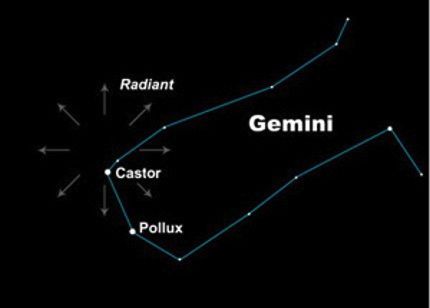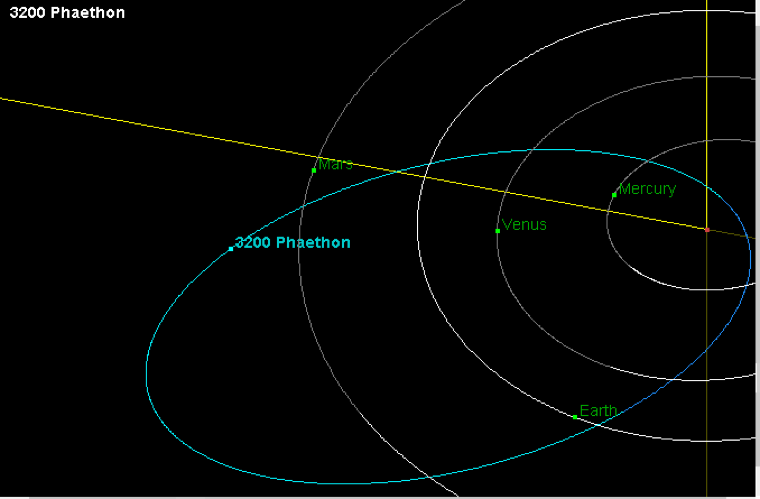December 13, 2017 6:13 pm
The Geminid Meteor Shower: Fun facts, tips, and a new meteor Q&A – 2017 Update
Today’s guest blog post is by StarTalk intern Kirk Long. Kirk is majoring in astrophysics while minoring in applied mathematics and piano at Boise State University. He spends his summer weekends working at the largest public observatory in Idaho, the Bruneau Sand Dunes State Park Observatory, where he gives educational astronomy presentations and operates various large telescopes for the public. Kirk also helps run the StarTalk Snapchat (startalk-radio).
Editor’s Note: This is an updated version to our post about the Geminids last year.
The Geminids peak this year on the night of December 13th into the early morning of the 14th. If you can’t make it out on the night of the peak, try going out on any night this week or a little into next and you’ll probably see a few Geminids. Our next new moon (the time when the sky is darkest and thus most conducive to spotting faint meteors) will be on the 17th, meaning that Geminid watchers should be in for a great show as moonlight interference won’t be a big deal. The Geminids are notorious for producing some of the brightest meteors of the year and are expected to produce about a meteor a minute, so even though it’s getting colder it’s worth it tobundle up and get outside. With the Geminids are predicted to fall at a rate of about 60 meteors an hour near the peak, the math says you should (hopefully) only have to brave the cold for a few minutes if you’re in a good vantage point to catch one. If skies are cloudy or you can’t make it outside, check out fireballs.ndc.nasa.gov, where you can see some of the more spectacular Geminid meteors from the warmth of your home.

The Geminid Radiant, courtesy of EarthSky.org.
The Geminids (like most other meteor showers) are named after the constellation from which the meteors appear to stream. This is called the radiant, and using the chart above from EarthSky can help you find the constellation Gemini during your observations. You don’t have to stare at the constellation all night, as meteors can and will appear anywhere in the sky, but if you trace their apparent path backwards you should end up near Gemini if it was a Geminid meteor. The Geminids we see burning up in the night sky are remnants of the “rock comet” Asteroid 3200 Phaethon.

3200 Phaethon’s orbit, from JPL Small-Body Database linked to in previous paragraph, which can only be seen if you’re using Internet Explorer or Firefox as it requires a Java plug-in.
Every year and a half or so, the three-mile-wide Phaethon swings in extremely close to the sun, rapidly heating up. This sudden increase in temperature bakes the asteroid resulting in fissures and fractures (think of the way mud in a lake bed will crack when baked under the sun) that eject material, leaving a trail of primordial dust and rock (nearly 5 billion years old!) that smashes into the Earth later at speeds up to 80,000 miles-per-hour. The only confirmed example of a rock comet is 3200 Phaethon, which makes the Geminids unique among meteor showers. Since it is primarily rocky instead of icy like most comets, the material expelled by it is usually denser and thus your chances of seeing a brighter, longer lasting meteor are higher. Although you’ll see the highest rate of Geminids later into the night (when the constellation Gemini is highest in the night sky), observing earlier in the evening presents the opportunity to see a rare “Earthgrazer.” Since the meteors will appear to radiate from Gemini, when the constellation is just rising and near the horizon, the meteors that stream from it (if large enough) will appear to cross the entire sky, a spectacular sight.
For last month’s Leonid meteor shower I wrote a post answering some common questions I’ve gotten about meteor showers, why you may see different colors, why they happen each year, and how they form (be sure to check it out if you’re curious). For the Geminids, I’ve collected an entirely new set of questions—a mini cosmic queries segment if you will—from several of my college-age friends. If you have questions about meteors we didn’t cover, be sure to ask them in the comments!
What is the annual amount of mass that strikes the Earth from meteors?
(Submitted by Mason B. from Idaho State University)
Short answer: Somewhere between 37,000-78,000 tons
This is incredibly hard to get an exact answer for. Several studies have tried to come up with a number over the years, and most calculate their numbers by measuring the amount of material that hits a specific area of the Earth and extrapolating from there to estimate the total amount that hits the Earth. Our best measurements indicate that this number is somewhere between 37,000 and 78,000 tons of material impacting the surface every year. If we were to spread this debris evenly across the surface of the Earth (and assuming an average density of 3g/cm3 for meteorite material) that means that a layer somewhere between 0.02 and 0.05 nanometers of meteorite dust would be deposited on the Earth each year. The average size of a human hair is between 18 and 108 nanometers, and if we use the upper end of that range (100 nanometers), that means it would take at least 2,000 years to accumulate a layer of meteorite dust to match a single human hair. To get to just a centimeter layer of cosmic dust would take at least 20 million years! Special thanks to my roommate Mason (who asked this question and is a geology major) for doing the math on this with me.
How deep into the atmosphere do meteors get before they burn up on average?
(Submitted by Jacie W. from Idaho State University)
Short answer: Around 40-60 miles above the surface
Long answer: Most meteors are small and thus burn up relatively quickly in the atmosphere, but how quickly depends largely on how fast the meteors impact the atmosphere. When a meteor strikes Earth’s atmosphere, it compresses the air in front of it, superheating it to temperatures as high as 3,000 degrees Fahrenheit. This in turn heats the meteor itself, vaporizing most within a second or two. If the meteor is travelling more quickly, it will heat up the atmosphere faster and thus vaporize faster, meaning that faster meteors generally burn up (and glow) at higher altitudes. For most major meteor showers, this range is somewhere between 40 and 60 miles above the Earth’s surface. You can find a good analysis of the major meteor showers and the speed at which they impact the atmosphere from EarthSky.
Could we create an artificial meteor shower?
(Submitted by Nika H. from University of California Berkeley)
Short Answer: Hypothetically, yes.
Long Answer: It’s complicated—and expensive. We have had artificial meteors before, as satellites and other waste burn up upon reentry in our atmosphere, but to create a true artificial meteor shower would require more coordination. It turns out there is a recent startup in Japan aiming to do just that. Their goal is to launch a series of satellites into orbit that will shoot small pellets at the atmosphere, creating artificial showers on demand for a plethora of occasions (including potentially the next Olympics). They’ll probably be pretty expensive shows, however: right now, the cost to launch things even into low earth orbit is still thousands of dollars per pound. Personally, I’m a bit skeptical of the feasibility and safety of this idea. Natural meteors impact the Earth much faster than these artificial meteors would, and they are smaller as well. The Japanese start-up plans to launch pellets about two centimeters in size slowly into the atmosphere at a pretty shallow angle. This will certainly create a brighter and longer lasting meteor than we would see naturally, but it also increases the chances of something getting through. Even if we’re 99.99% certain that no debris will make it through, that 0.01% is a lawsuit waiting to happen when someone’s house, car, or person is damaged by an artificial shooting star.
How often do meteors occur?
(Submitted by Makia P. from Idaho State University)
Short Answer: Generally, between 1-10 per hour, with meteor showers reaching 10-50, and meteor storms hundreds or even thousands
Long Answer: Even without a meteor shower, there’s a constant background rate of meteors impacting our atmosphere. How many you can see at any given time depends on a few factors, although the largest is probably how much light pollution your area of the sky has and what phase the moon is in (the more illuminated the moon is, the more it washes out fainter objects). The other main factors are what season your observing site is in and how late into the night it is. The side of the Earth that faces “forwards” (i.e. the side that’s facing the direction the Earth travels in its orbit) will encounter more meteors per hour than the trailing side of the Earth will. Meteors hitting the Earth on the backside have to “catch up” to us as we orbit the sun, whereas the “front” of the Earth plows through extra meteors in our path. As the night goes on, the side of the Earth you are on rotates closer to the leading edge of the Earth, thus the apparent frequency of meteors will increase. Seasons change as a result of the Earth’s tilt, and this also affects the frequency of meteors you might see at a given time. Generally, during the fall you might see 2-3 times as many meteors compared to what you would see in the spring (from the Northern Hemisphere—this phenomenon is reversed for Southern observers). With all these factors, the rate of meteors you might see at any given time varies greatly, from less than one per hour to as many as 10. Normally meteor showers can bump this rate up to between 10 and 50 meteors per hour, and special years with “meteor storms” can see hundreds or even thousands per hour, although these events are rare and hard to predict. For more information on these phenomena, check out this great resource from the American Meteor Society.
What’s the difference between meteors, meteorites, and meteoroids?
(submitted by Raquel S. from Idaho State University)
Short answer: Meteors=in atmosphere; meteorites=in the ground; meteoroids=in space
Long Answer: This is a common source of confusion for people who aren’t nerds like me and don’t enjoy reading astronomy textbooks in their free time. As far as meteors go, there’s basically three “stages” to their classification. When they’re still in space, we label them as meteoroids—these particles are normally less than a centimeter in size and are mostly (in the case of meteor showers) debris expelled from comets (the main exception being the Geminids). Once they impact the atmosphere and begin to burn up, they become the meteors we are all so familiar with. Nearly all meteors end their lives that way, but a good rule of thumb is that if the meteor is larger than the size of your fist, there’s a chance it might survive entry and hit the Earth, becoming a meteorite. Big impacts do happen on occasion (see: the end of the dinosaurs), but they’re exceedingly rare and we would see an object that size coming. Be sure to check out our Cosmic Queries episode from season 4, where Neil and Chuck Nice tackle questions on asteroids, comets, and meteor storms.
When is the best time and what is the best way to look for meteors?
(Submitted by Bailey N. from Boise State University)
Short Answer: Anytime is a good time to watch for meteors!
Long Answer: In a perfect world we could all stay up until 3 AM in a dark sky location to watch meteor showers, but the reality is conditions (both in our busy lives and in the sky) rarely line up to make that a reality. In general, the later you can stay up to watch a meteor shower the better. You’ll also want to try to look for meteors on a night with as little glare from the moon and other light sources as possible. Finally, don’t go out alone! Meteor watching is always more fun with a partner, and it makes an excellent date night. I also recommend bringing a telescope or binoculars along to get in as much observing as possible. The planets are all easy targets to find even for a novice astronomer, and with the assistance of a sky chart (especially in one of the many smartphone apps available these days) you can find almost anything with a little trial and error.
Do you have any questions you’d like answered about meteors and/or meteor showers? Ask them in the comments and we might feature them in a future blog post.
Get the most out of StarTalk!
Ad-Free Audio Downloads
Ad-Free Video Episodes
Stickers & Mugs
Live Streams with Neil
Priority Cosmic Queries
Early-Access Videos
Learn the Meaning of Life
...and much more

 Become a Patron
Become a Patron

